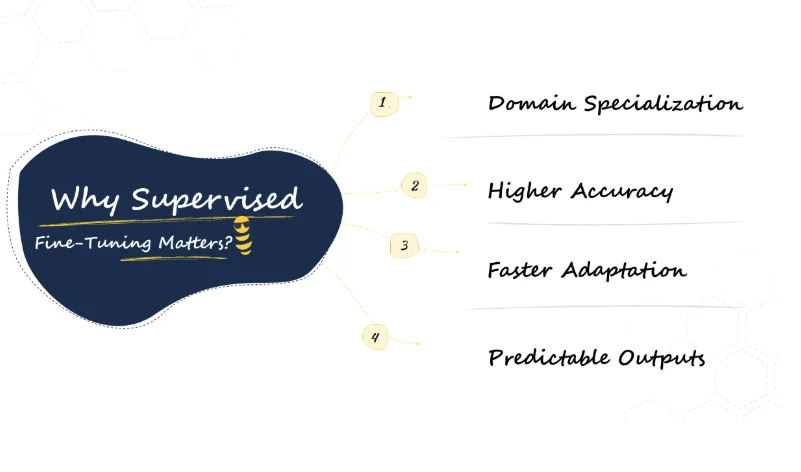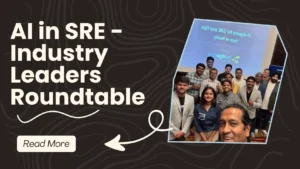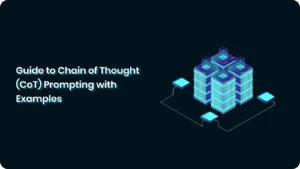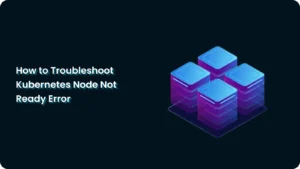Supervised Fine-Tuning Vs RLHF Vs RL: Differences and Role in LLMs

Understand Supervised Fine-Tuning, RLHF, and RL differences in LLMs. Compare methods on efficiency, flexibility. Gain insights; choose smartly.
Ever wondered how those super-smart Large Language Models (LLMs) get so good at understanding and generating human-like text? Well, it is a process of careful tailoring called fine-tuning!
Now, when it comes to fine-tuning LLMs, things get interesting with three main approaches: Supervised Fine-Tuning (SFT), Reinforcement Learning (RL), and Reinforcement Learning from Human Feedback (RLHF). SFT is like teaching the model with a textbook full of examples.
RL is where the model learns through trial and error, receiving rewards for good behavior. RLHF takes it a step further by incorporating actual human preferences. And with the rise of AI, there’s now Reinforcement Learning with AI Feedback (RLAIF), offering similar benefits as RLHF but with fewer resources.
So, how do these methods stack up against each other? What roles do they play in shaping the LLMs we use every day? Let’s get in and explore how each approach shapes the future of AI.
Supervised Fine-Tuning (SFT) in LLMs
Supervised Fine-Tuning (SFT) is a training method that enhances a pre-trained Large Language Model (LLM) by using labeled datasets. This process refines the model’s ability to generate accurate, contextually relevant responses for specific tasks.
By repeatedly training on high-quality, domain-specific examples, the model becomes more precise, efficient, and aligned with real-world application. However, its effectiveness depends on data quality, as biases or errors in the labeled dataset can directly impact model performance.
How Supervised Fine-Tuning Works?
Supervised Fine-Tuning (SFT) refines a pre-trained LLM using labeled datasets, ensuring it generates accurate and task-specific responses. By learning from structured input-output pairs, the model improves efficiency and reliability for targeted applications.
Let’s break down the step-by-step process of SFT.
- Start with a pre-trained LLM – Think of it like a student who has completed general education but needs specialized training in a particular field.
- Feed it labeled data – High-quality datasets with clear input-output mappings help the model understand what responses are expected.
- Adjust model parameters – The LLM learns to refine its outputs, aligning closely with the desired format, tone, and accuracy.
- Validate and iterate – The fine-tuned model is tested and further improved based on performance evaluations.
For example, if an LLM is being fine-tuned for legal document analysis, it will be trained with thousands of labeled legal cases, contracts, and precedents to ensure precise language and domain-specific expertise.
Why Supervised Fine-Tuning Matters?

Pre-trained Large Language Models (LLMs) provide a strong foundation, but they often lack the precision needed for specific tasks. Supervised Fine-Tuning (SFT) bridges this gap by training models with labeled data, improving accuracy, consistency, and alignment with real-world applications.
- Domain Specialization: Makes general-purpose LLMs highly effective for industry-specific tasks like healthcare, finance, and legal applications.
- Higher Accuracy: Since the model learns from explicitly labeled data, it provides more reliable and structured responses compared to unsupervised learning.
- Faster Adaptation: Requires less computational power compared to reinforcement learning, making it a cost-effective solution for many businesses.
- Predictable Outputs: Ensures consistent formatting and tone, making it ideal for applications like customer support, legal advisories, and financial reporting.
Challenges of Supervised Fine-Tuning
While Supervised Fine-Tuning (SFT) is essential for refining Large Language Models (LLMs), it comes with its own set of challenges. From the need for high-quality labeled data to the risk of catastrophic forgetting, these obstacles can impact the effectiveness of fine-tuning.
Here are a few key challenges to consider when implementing SFT.
- Data Dependency: The effectiveness of SFT is only as good as the quality of labeled data. Poorly labeled datasets can lead to biased or inaccurate outputs.
- Limited Generalization: Once fine-tuned for a specific task, the model might struggle with questions outside its training scope. This is known as overfitting.
- Catastrophic Forgetting: Training on new datasets can overwrite previous knowledge, making it difficult to maintain a broad understanding of various topics.
- Time & Cost Constraints: Creating high-quality labeled datasets can be time-consuming and expensive, especially for highly specialized fields.
Supervised Fine-Tuning is the first step in shaping powerful AI models. While it has its limitations, it lays the groundwork for high-performance AI applications. In many cases, it is later combined with Reinforcement Learning from Human Feedback (RLHF) to further refine responses based on real-world human preferences.
Reinforcement Learning from Human Feedback (RLHF) in LLMs
As AI becomes more integrated into real-world applications, ensuring that models generate responses aligned with human values and expectations is critical.
Reinforcement Learning from Human Feedback (RLHF) bridges the gap between machine intelligence and human preference by incorporating human evaluation into the learning process.
This method enables Large Language Models (LLMs) to refine their outputs dynamically, improving coherence, ethical alignment, and user satisfaction.
How RLHF Works?
Unlike Supervised Fine-Tuning (SFT), which relies on static labeled datasets, RLHF uses human preference feedback to continuously adjust the model’s behavior. The process typically involves:
- Pre-training the Model – The LLM is initially trained using traditional supervised learning methods.
- Generating Multiple Responses – The model produces different possible outputs for a given prompt.
- Human Feedback Collection – Humans rank these responses based on relevance, coherence, helpfulness, or ethical considerations.
- Training a Reward Model – A separate model learns to predict which outputs are preferable based on human rankings.
- Optimizing the Model with Reinforcement Learning – Using reinforcement learning algorithms (e.g., Proximal Policy Optimization or PPO), the LLM is fine-tuned to generate responses that align with human preferences.
This iterative process teaches the model to prioritize outputs that are useful, unbiased, and contextually appropriate, making RLHF a powerful tool for aligning AI with human expectations
Benefits of RLHF
Reinforcement Learning from Human Feedback (RLHF) bridges the gap between machine intelligence and human values, making LLMs more aligned, ethical, and context-aware.
Here are a few benefits of RLHF.
- Enhanced Alignment with Human Values – The model refines its responses based on direct human input, reducing instances of biased or harmful outputs.
- Improved Contextual Understanding – RLHF helps the model grasp nuanced language structures, sarcasm, and ethical dilemmas better than purely supervised training.
- Greater Adaptability to Real-World Use Cases – Since human feedback can be tailored for different applications, models fine-tuned with RLHF are highly flexible.
- Reduction in Hallucinations – By prioritizing human-preferred responses, RLHF helps minimize incorrect or misleading AI-generated content.
For example, ChatGPT and Claude use RLHF to enhance their conversational abilities, making them more engaging, helpful, and less prone to generating harmful responses.
Challenges of RLHF
While Reinforcement Learning from Human Feedback (RLHF) improves LLM alignment with human preferences, it comes with significant challenges, such as;
- High Cost and Complexity – Gathering large-scale human feedback is expensive and time-consuming, requiring diverse human reviewers.
- Subjectivity in Human Preferences – Different users may have varying opinions on what constitutes a “good” response, leading to inconsistencies.
- Risk of Overfitting to Feedback Loops – If human feedback is biased or flawed, the model may reinforce unintended biases over time.
- Computationally Intensive – Training a reward model and continuously fine-tuning an LLM with reinforcement learning demands substantial computing resources.
Despite these challenges, RLHF remains one of the most effective strategies for improving AI-generated content, particularly in ethically sensitive domains like healthcare, legal advisory, and journalism.
When Should You Use RLHF?
Reinforcement Learning from Human Feedback (RLHF) is ideal when human alignment, ethical considerations, and nuanced decision-making are crucial. If you need an LLM that generates context-aware, unbiased, and user-preferred responses, RLHF helps fine-tune the model based on real human preferences rather than static datasets.
Here’s when you should use RLHF.
- When adaptability is crucial – RLHF helps models adjust dynamically to evolving requirements, such as personalized chatbots and AI-assisted tutoring.
- For improving user satisfaction – AI-driven customer support and conversational AI benefit significantly from human-guided feedback loops.
- To align AI with ethical considerations – Ensures that LLMs used in legal, medical, or financial applications generate responsible, well-structured responses.
As AI continues to evolve, RLHF will play a pivotal role in ensuring safer, more ethical, and highly adaptive models.
With RLHF, you can build AI systems that understand context, adapt to human preferences, and improve user experiences, setting a new standard for interactive AI solutions.
Reinforcement Learning (RL) in LLMs
Reinforcement Learning (RL) is one of the most powerful and dynamic machine learning paradigms, allowing models to learn through trial and error. RL enables models to make decisions independently based on rewards and penalties.
When applied to Large Language Models (LLMs), RL can help develop more adaptive, self-improving AI systems that optimize responses based on long-term performance goals rather than just immediate correctness.
How Reinforcement Learning Works in LLMs
Reinforcement Learning follows the agent-environment interaction model, where the AI (agent) takes actions, receives feedback (reward or penalty), and adjusts its future behavior accordingly. In the context of LLMs, this process involves:
- Defining the State – The input context provided to the LLM (e.g., a question or prompt).
- Generating an Action – The model produces a response based on its learned policy.
- Receiving a Reward – The response is evaluated using a reward function, which may be automatically defined (algorithmic rewards) or manually guided (human feedback in RLHF).
- Optimizing the Model – The AI updates its policy using reinforcement learning techniques, such as Proximal Policy Optimization (PPO), Q-learning, or Actor-Critic methods.
Unlike traditional supervised learning, where learning stops once the training phase is complete, RL enables continuous improvement by constantly refining the model’s response generation strategies.
Key Advantages of RL in LLMs
- Autonomous Learning – RL allows LLMs to refine their responses without requiring human intervention at every step.
- Optimized Decision-Making – The model can be trained to maximize long-term objectives, such as maintaining user engagement or reducing misinformation.
- Adaptability to Dynamic Environments – RL-based models can adjust to new trends, domains, and tasks without requiring a complete retraining cycle.
- Handling Multi-Turn Interactions – For applications like chatbots and virtual assistants, RL helps optimize responses based on conversation history rather than isolated prompts.
For example, AlphaGo, one of the most famous RL-based AI systems, learned to play Go at a superhuman level purely by optimizing its reward structure. Similarly, RL can be used to fine-tune LLMs for goal-oriented tasks like strategic planning, content summarization, or AI-driven negotiations.
Challenges of RL in LLMs
Despite its benefits, RL comes with significant challenges, especially when applied to language models:
- Defining Reward Functions – Unlike games where rewards are clear (winning vs. losing), rewarding language generation is subjective and often requires human input.
- Computational Intensity – Training LLMs with RL demands substantial computing power, as the model constantly explores, updates, and optimizes its responses.
- Risk of Exploiting Rewards – If an LLM misinterprets reward signals, it may generate responses that technically maximize rewards but fail to align with human expectations.
- Limited Generalization – Unlike RLHF, which aligns AI with human values, pure RL models may prioritize mechanical reward maximization over meaningful interaction.
These challenges highlight why pure RL is rarely used in isolation for LLMs. Instead, hybrid models combining SFT, RLHF, and RL are more effective, ensuring both performance optimization and human-aligned responses.
Applications of RL in LLMs
Despite its limitations, RL plays a crucial role in enhancing AI-driven interactions across multiple domains:
- Conversational AI – RL optimizes chatbot responses based on user engagement metrics.
- Personalized Content Recommendations – Streaming platforms and news aggregators use RL to suggest content based on user behavior.
- Autonomous Code Generation – AI-powered coding assistants refine their recommendations by learning from developer feedback and success rates.
- Game AI Development – RL has been used in training AI opponents in video games, poker, and strategic simulations.
By leveraging RL, organizations can develop more sophisticated AI models that learn, adapt, and improve over time—paving the way for next-generation intelligent systems.
Comparison Between SFT, RLHF, and RL
When fine-tuning Large Language Models (LLMs), selecting the right training methodology is crucial for achieving the desired performance, efficiency, and alignment with human expectations.
Understanding their key differences can help you decide the best approach based on your specific LLM training goals.
Let’s take a quick look at this table.
| Feature | Supervised Fine-Tuning (SFT) | Reinforcement Learning from Human Feedback (RLHF) | Reinforcement Learning (RL) |
|---|---|---|---|
| Learning Approach | Trains on labeled datasets with explicit input-output pairs | Uses human preferences to train a reward model for better responses | Uses trial and error with rewards to optimize response generation |
| Data Requirement | Requires large, high-quality labeled datasets | Requires human feedback on model outputs | Requires a well-defined reward structure for autonomous learning |
| Adaptability | Limited to predefined tasks and dataset scope | Adapts to human preferences and ethical considerations | Learns from experience, making it more flexible but harder to control |
| Feedback Source | Fixed dataset with labeled examples | Human rankings and preference scores | Algorithmic reward function, possibly with some human oversight |
| Training Complexity | Relatively straightforward but requires extensive labeled data | Complex due to human involvement in training the reward model | Highly complex, involving multiple training cycles and optimization steps |
| Alignment with Human Values | Limited, as it depends on dataset quality and diversity | High, as human preferences guide the learning process | May not align with human intent unless explicitly designed to do so |
| Efficiency | Fast and efficient for well-defined tasks | More resource-intensive than SFT but ensures better human alignment | Computationally expensive due to constant exploration and learning |
| Risk of Bias | Inherits biases from training dataset | Less biased than SFT due to human corrections, but still dependent on diverse feedback | May develop unintended behaviors if the reward function is poorly designed |
| Use Cases | Domain-specific fine-tuning, customer support bots, language translation | Ethical AI, content moderation, chatbots that align with user preferences | Game-playing AI, real-time adaptation, personalized recommendations |
| Challenges | Requires high-quality labeled data, struggles with new tasks outside its dataset | Expensive and time-consuming to gather large-scale human feedback | Defining an effective reward function is difficult, risk of reward hacking |
| Best For | Tasks with structured datasets and clear outputs | Use cases where human alignment is crucial | Scenarios requiring autonomous adaptation and decision-making |
How NudgeBee Enhances LLM Training?
Optimizing Large Language Models (LLMs) requires real-time insights, performance tracking, and user-driven feedback loops. NudgeBee offers a comprehensive AI analytics and monitoring platform designed to fine-tune LLMs efficiently by gathering actionable insights from real-world user interactions.
Key Features of NudgeBee:
- Automated Remediation: NudgeBee offers automated remediation capabilities, allowing for event-triggered responses and ticket monitoring to swiftly address issues as they arise.
- FinOps Agent: For financial operations, NudgeBee provides continuous real-time optimization, including right-sizing of resources such as memory, CPU, and storage for applications and persistent volumes.
- CloudOps Agent: NudgeBee’s CloudOps Agent focuses on security and vulnerability identification, including CVE scans and Kubernetes version upgrades. It addresses vulnerabilities by creating tickets and recommending changes, ensuring your cloud operations remain secure and efficient.
NudgeBee’s platform is built to assist Site Reliability Engineers (SREs), support developers, FinOps teams, infrastructure teams, and DevOps teams, offering you business benefits such as reducing issue resolution times from hours to minutes and achieving 30-60% cost reductions on top of existing manual efforts.
Conclusion
Choosing between Supervised Fine-Tuning (SFT), RLHF, and RL depends on your goals. SFT helps you refine models with structured data, RLHF improves alignment with human preferences, and RL enables adaptability through reward-based learning. In many cases, a combination of these methods works best.
With NudgeBee’s suite of tools, you can make your LLMs smarter, more aligned, and continuously improving.
Refine, Optimize, and Scale with NudgeBee – Get deeper insights into your AI models, detect inefficiencies, and ensure continuous learning.





